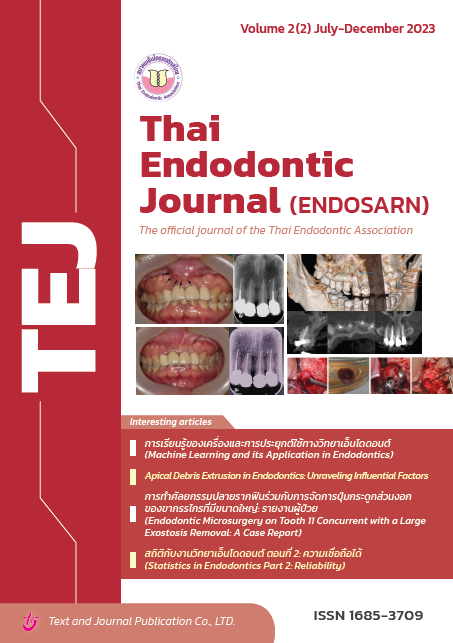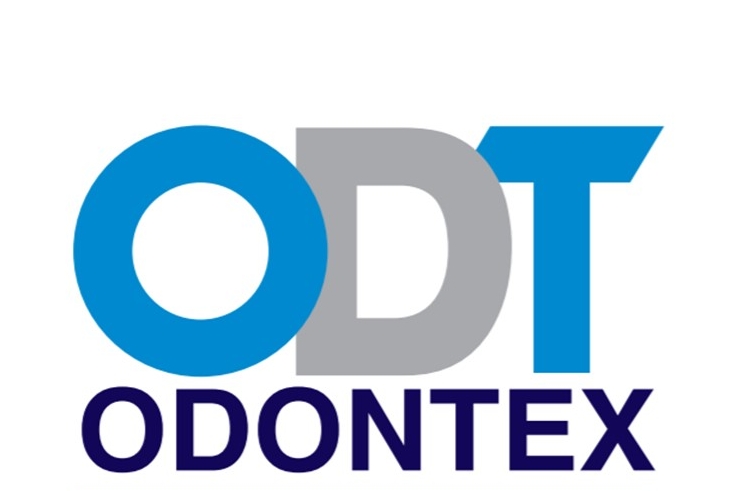การเรียนรู้ของเครื่องและการประยุกต์ใช้ทาง วิทยาเอ็นโดดอนต์
คำสำคัญ:
การเรียนรู้ของเครื่อง, การเรียนรู้เชิงลึก, ประสิทธิภาพโมเดล, วิทยาเอ็นโดดอนต์, การรักษาคลองรากบทคัดย่อ
การเรียนรู้ของเครื่อง (machine learning) เป็นศาสตร์สาขาหนึ่งทางปัญญาประดิษฐ์ที่เริ่มเข้ามามีบทบาทในทางทันตกรรมจากความก้าวหน้าทางวิทยาการคอมพิวเตอร์และวิทยาการข้อมูล เริ่มมีการนำมาประยุกต์ใช้ในทางวิทยาเอ็นโดดอนต์ เช่น การระบุรอยโรครอบปลายรากในภาพรังสี การจำแนกลักษณะคลองราก การตรวจสอบรากฟันแตก เป็นต้น ส่วนใหญ่จะใช้การเรียนรู้ของเครื่องแบบ supervised machine learning โดยมนุษย์จัดเตรียมชุดข้อมูลนำเข้าพร้อมป้ายกำกับให้คอมพิวเตอร์เรียนรู้โดยใช้สมการทางสถิติศาสตร์และสร้างเป็นโมเดลที่ซับซ้อน จากนั้นประเมินประสิทธิภาพของโมเดลที่สร้างขึ้นเมื่อมีประสิทธิภาพเพียงพอจึงนำไปใช้งานจริง ข้อมูลส่วนใหญ่ที่ใช้ในงานวิจัยทางวิทยาเอ็นโดดอนต์จะเป็นข้อมูลรูปภาพและภาพรังสีที่จะใช้วิธีการเรียนรู้แบบ convolution neural network (CNN) ในการสกัดข้อมูลสำคัญเพื่อสร้างโมเดล ผลการศึกษาส่วนใหญ่พบว่าการเรียนรู้เครื่องมีประสิทธิภาพ เพิ่มความแม่นยำในการปฏิบัติงานและลดเวลาการตัดสินของมนุษย์ มีแนวโน้มที่สามารถนำมาใช้เสริมการปฏิบัติงานให้มีประสิทธิภาพมากขึ้นได้
References
Park WJ, Park JB. History and application of artificial neural networks in dentistry. Eur J Dent. 2018;12(4):594-601.
Fatima A, Shafi I, Afzal H, Díez IT, Lourdes DRM, Breñosa J, et al. Advancements in dentistry with artificial intelligence: current clinical applications and future perspectives. Healthcare (Basel). 2022;10(11).
Papantonopoulos G, Takahashi K, Bountis T, Loos BG. Artificial neural networks for the diagnosis of aggressive periodontitis trained by immunologic parameters. PLoS One. 2014;9(3):e89757.
Geetha V, Aprameya KS, Hinduja DM. Dental caries diagnosis in digital radiographs using back-propagation neural network. Health Inf Sci Syst. 2020;8(1):8.
Shankarapillai RM, L.K.; Nair, M.A.; George, R. Periodontitis risk assessment using two artificial neural network algorithms—A comparative study. Int J Dental Clin. 2012;4:17-21.
Cui Q, Chen Q, Liu P, Liu D, Wen Z. Clinical decision support model for tooth extraction therapy derived from electronic dental records. J Prosthet Dent. 2021;126(1):83-90.
Choi HI, Jung SK, Baek SH, Lim WH, Ahn SJ, Yang IH, et al. Artificial intelligent model with neural network machine learning for the diagnosis of orthognathic surgery. J Craniofac Surg. 2019;30(7):1986-9.
Javed S, Zakirulla M, Baig RU, Asif SM, Meer AB. Development of artificial neural network model for prediction of post-streptococcus mutans in dental caries. Comput Methods Programs Biomed. 2020;186:105198.
Turing AM. Computing machinery and intelligence. Mind. 1950;59(236):433-60.
Oppy GaD, David. The Turing Test. In: Zalta EN, editor. Winter 2021 ed: Metaphysics Research Lab, Stanford University; 2021.
Bostrom N. Superintelligence: Paths, dangers, strategies. New York, NY, US: Oxford University Press; 2014. xvi, 328-xvi, p.
Choi RY, Coyner AS, Kalpathy-Cramer J, Chiang MF, Campbell JP. Introduction to machine learning, neural networks, and deep learning. Transl Vis Sci Technol. 2020;9(2):14.
Rashidi HH, Tran NK, Betts EV, Howell LP, Green R. Artificial intelligence and machine learning in pathology: The present landscape of supervised methods. Acad Pathol. 2019;6:2374289519873088.
Ren R, Luo H, Su C, Yao Y, Liao W. Machine learning in dental, oral and craniofacial imaging: a review of recent progress. PeerJ. 2021;9:e11451.
Moore MM, Slonimsky E, Long AD, Sze RW, Iyer RS. Machine learning concepts, concerns and opportunities for a pediatric radiologist. Pediatr Radiol. 2019;49(4):509-16.
Anwar SM, Majid M, Qayyum A, Awais M, Alnowami M, Khan MK. Medical image analysis using convolutional neural networks: a review. J Med Syst. 2018;42(11):226.
Ronneberger O, Fischer P, Brox T, editors. U-Net: Convolutional networks for biomedical image segmentation. medical image computing and computer-assisted intervention – MICCAI 2015; Cham: Springer International Publishing.
He K, Zhang X, Ren S, Sun J, editors. Deep residual learning for image recognition. 2016 IEEE conference on computer vision and pattern recognition (CVPR); 2016 27-30 June 2016.
Chollet F, editor Xception: Deep learning with depthwise separable convolutions. 2017 IEEE conference on computer vision and pattern recognition (CVPR); 2017 21-26 July 2017.
Schneider A, Hommel G, Blettner M. Linear regression analysis: part 14 of a series on evaluation of scientific publications. Dtsch Arztebl Int. 2010;107(44):776-82.
Gareth James DWTHRT. An introduction to statistical learning : with applications in R: New York : Springer, [2013] ©2013; 2013.
Wu H, Jun Meng F. Review on evaluation criteria of machine learning based on big data. J Phys: Conference Series. 2020;1486(5):052026.
Bradley AP. The use of the area under the ROC curve in the evaluation of machine learning algorithms. Pattern Recognition. 1997;30(7):1145-59.
Mallishery S, Chhatpar P, Banga KS, Shah T, Gupta P. The precision of case difficulty and referral decisions: an innovative automated approach. Clin Oral Investig. 2020;24(6):1909-15.
Qu Y, Lin Z, Yang Z, Lin H, Huang X, Gu L. Machine learning models for prognosis prediction in endodontic microsurgery. J Dent. 2022;118:103947.
Rud J, Andreasen JO, Jensen JE. Radiographic criteria for the assessment of healing after endodontic surgery. Int J Oral Surg. 1972;1(4):195-214.
Molven O, Halse A, Grung B. Observer strategy and the radiographic classification of healing after endodontic surgery. Int J Oral Maxillofac Surg. 1987;16(4):432-9.
Sherwood AA, Sherwood AI, Setzer FC, K SD, Shamili JV, John C, et al. A deep learning approach to segment and classify C-Shaped canal morphologies in mandibular second molars using cone-beam computed tomography. J Endod. 2021;47(12):1907-16.
Hiraiwa T, Ariji Y, Fukuda M, Kise Y, Nakata K, Katsumata A, et al. A deep-learning artificial intelligence system for assessment of root morphology of the mandibular first molar on panoramic radiography. Dentomaxillofac Radiol. 2019;48(3):20180218.
Li S, Liu J, Zhou Z, Zhou Z, Wu X, Li Y, et al. Artificial intelligence for caries and periapical periodontitis detection. J Dent. 2022;122:104107.
Pauwels R, Brasil DM, Yamasaki MC, Jacobs R, Bosmans H, Freitas DQ, et al. Artificial intelligence for detection of periapical lesions on intraoral radiographs: comparison between convolutional neural networks and human observers. Oral Surg Oral Med Oral Pathol Oral Radiol. 2021;131(5):610-6.
Ekert T, Krois J, Meinhold L, Elhennawy K, Emara R, Golla T, et al. Deep learning for the radiographic detection of apical lesions. J Endod. 2019;45(7):917-22.e5.
Endres MG, Hillen F, Salloumis M, Sedaghat AR, Niehues SM, Quatela O, et al. Development of a deep learning algorithm for periapical disease detection in dental radiographs. Diagnostics (Basel). 2020;10(6).
Birdal RG, Gumus E, Sertbas A, Birdal IS. Automated lesion detection in panoramic dental radiographs. Oral Radiol. 2016;32(2):111-8.
Orhan K, Bayrakdar IS, Ezhov M, Kravtsov A, Özyürek T. Evaluation of artificial intelligence for detecting periapical pathosis on cone-beam computed tomography scans. Int Endod J. 2020;53(5):680-9.
Setzer FC, Shi KJ, Zhang Z, Yan H, Yoon H, Mupparapu M, et al. Artificial Intelligence for the computer-aided detection of periapical lesions in cone-beam computed tomographic images. J Endod. 2020;46(7):987-93.
Okada K, Rysavy S, Flores A, Linguraru MG. Noninvasive differential diagnosis of dental periapical lesions in cone-beam CT scans. Med Phys. 2015;42(4):1653-65.
Kositbowornchai S, Plermkamon S, Tangkosol T. Performance of an artificial neural network for vertical root fracture detection: an ex vivo study. Dent Traumatol. 2013;29(2):151-5.
Fukuda M, Inamoto K, Shibata N, Ariji Y, Yanashita Y, Kutsuna S, et al. Evaluation of an artificial intelligence system for detecting vertical root fracture on panoramic radiography. Oral Radiol. 2020;36(4):337-43.
Vicory J, Chandradevan R, Hernandez-Cerdan P, Huang WA, Fox D, Qdais LA, et al. Dental microfracture detection using wavelet features and machine learning. Proc SPIE Int Soc Opt Eng. 2021;11596.
Johari M, Esmaeili F, Andalib A, Garjani S, Saberkari H. Detection of vertical root fractures in intact and endodontically treated premolar teeth by designing a probabilistic neural network: an ex vivo study. Dentomaxillofac Radiol. 2017;46(2):20160107.
Saghiri MA, Asgar K, Boukani KK, Lotfi M, Aghili H, Delvarani A, et al. A new approach for locating the minor apical foramen using an artificial neural network. Int Endod J. 2012;45(3):257-65.
Saghiri MA, Garcia-Godoy F, Gutmann JL, Lotfi M, Asgar K. The reliability of artificial neural network in locating minor apical foramen: a cadaver study. J Endod. 2012;38(8):1130-4.
Qiao X, Zhang Z, Chen X. Multifrequency impedance method based on neural network for root canal length measurement. Appl Sci. 2020;10(21):7430.
Gao X, Xin X, Li Z, Zhang W. Predicting postoperative pain following root canal treatment by using artificial neural network evaluation. Sci Rep. 2021;11(1):17243.
Shen D, Wu G, Suk HI. Deep learning in medical image analysis. Annu Rev Biomed Eng. 2017;19:221-48.
Hosny A, Parmar C, Quackenbush J, Schwartz LH, Aerts H. Artificial intelligence in radiology. Nat Rev Cancer. 2018;18(8):500-10.
Asiri AF, Altuwalah AS. The role of neural artificial intelligence for diagnosis and treatment planning in endodontics: a qualitative review. Saudi Dent J. 2022;34(4):270-81.
Downloads
เผยแพร่แล้ว
How to Cite
ฉบับ
บท
License
Copyright (c) 2023 วารสารเอ็นโดดอนติกส์ไทย

This work is licensed under a Creative Commons Attribution-NonCommercial-NoDerivatives 4.0 International License.
Thai Endod Journal is licensed under a Creative Commons Attribution-NonCommercial-NoDerivatives 4.0 International (CC BY-NC-ND 4.0) license, unless otherwise stated. Please read our Policies in Copyright for more information.




